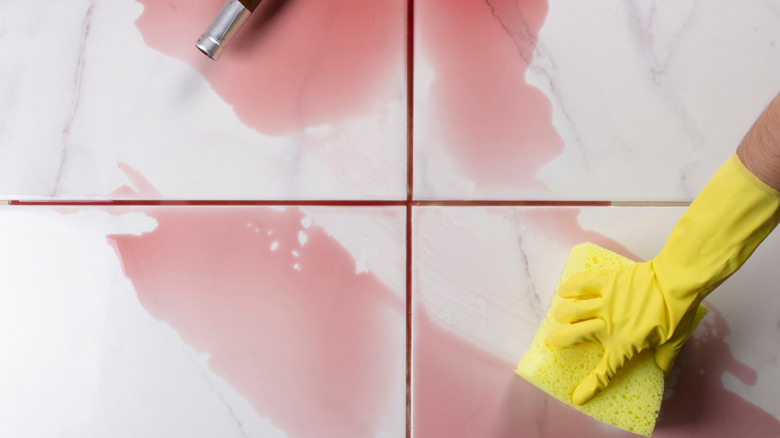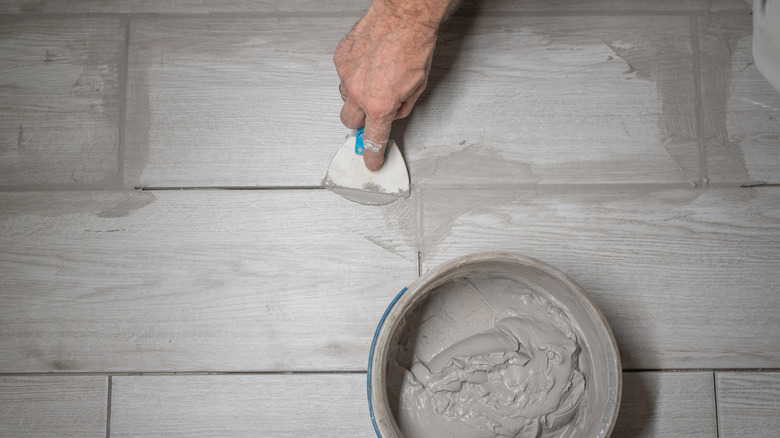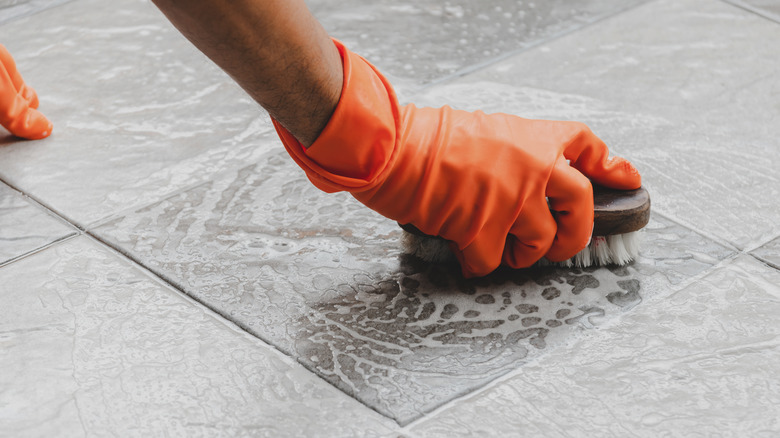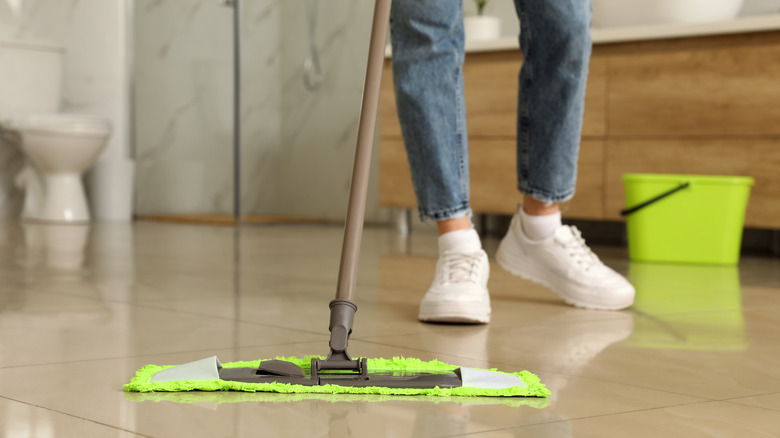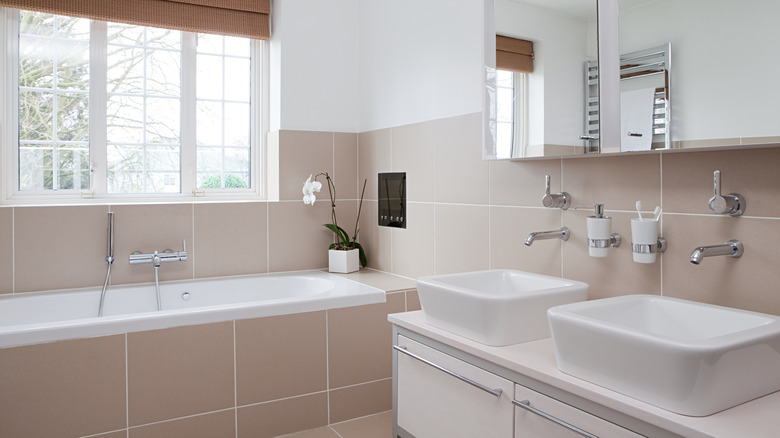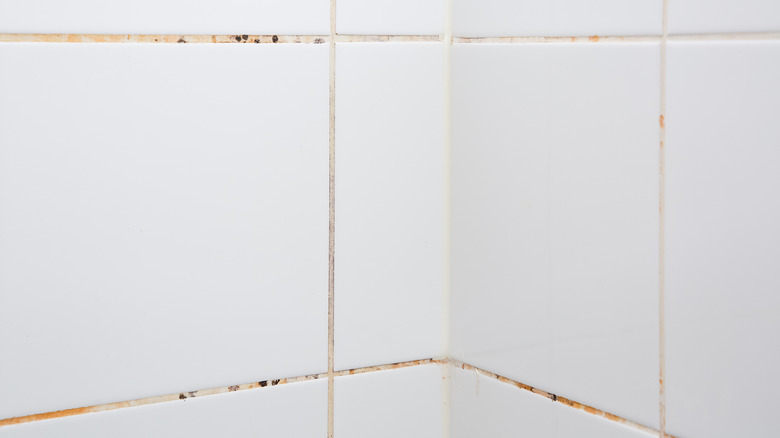An Expert Tells Us How To Keep Your Tile Grout Stain-Free
Since as far back as 4,700 B.C., humans have used tiles in their homes, temples, and other buildings (via The Victorian Emporium). From decorative tiles of the Victorian era to tile countertops of the 1980s and '90s, tile has earned its place as a staple building material for wet, damp, and high-traffic areas. Despite their long-standing reputation, tile surfaces still come with some disadvantages. After thousands of years, you'd think humans might have discovered a way to prevent and remove grout stains, yet the endless grout-cleaning struggle remains.
In an exclusive interview with House Digest, Kevin Bingham, a tile expert at Tile Warehouse, tells us his best advice for keeping your tile's grout stain-free. Bingham says, "While grout does a great job of keeping the tiles together brilliantly, its porous texture and staple 'light' coloring does make it notoriously difficult to keep clean without regular maintenance." Appearance isn't the only problem with dirty, stained tile grout. As Bingham explains, "poorly-maintained grout can lead to cracks and water damage to the walls or flooring behind the tiles — an expensive fix for something that could be prevented with a few simple steps."
Choosing the right grout
As the saying goes in medicine, an ounce of prevention is worth a pound of cure. Outside of health concerns, this adage can also be applied to your tile grout. When installing tile on your floors or walls, choosing the right grout is crucial to preventing stains. Kevin Bingham explains that people typically opt for the cheaper grout, but this isn't always the best solution. Bingham says, "Cement-based grouts are relatively inexpensive, which makes them a lot more popular when working on a DIY project. However, if you're looking for a slightly more expensive product which is both waterproof and stain-proof, epoxy-based grouts are the way to go."
Epoxy is a plastic polymer-like material that forms a smooth, water-tight surface when it dries. As Bingham explains, epoxy-based grout mixtures are "a lot more suitable and sustainable for areas of the home such as kitchens, bathrooms, and inside showers. Unlike cement-based grout, epoxy-based grout is much less likely to stain or crack as it is made to perform in wet environments." Although they're more expensive upfront, epoxy-based grouts can save you a lot of money on cleaning products and future grout resealing jobs.
Using the right cleaning products
Contrary to popular belief, grouted tiles won't always hold up to everything you throw at them. Harsh chemical cleaners may seem great for lifting visible stains, but they can actually cause more harm than good. Before spraying, soaking, and scrubbing Kevin Bingham says, "It's always safest to check in with your supplier to ensure you're using the right products for the materials you're dealing with. That being said, we'd always recommend testing the cleaner in a non-visible area before applying it throughout a room."
If you prefer to use homemade floor cleaner, Flooring Inc. recommends opting for gentle ingredients like water, vinegar, baking soda, and dish soap. Most importantly, Bingham says, "Avoid bleach-based products, as they will weaken the grout over time and potentially cause damage to the material. Even if you've selected a darker-colored grout than usual, bleach can cause it to fade over time." You can also purchase pre-mixed floor and grout cleaners, which may be your best bet if you want to protect floors from damage. For the best stain lifting results and built-in stain prevention, Bingham says, "We'd recommend using cleaning products with VOC-free water-based technology, such as the Fila Fugaproof Grout Protector Spray, no matter what type of grouting you have installed."
Make sure you're cleaning your tiles correctly
When it comes to protecting and preserving grout, your cleaning methods are just as important as your cleaning materials. Using as much elbow grease as possible may seem like a good idea, but you'll want to avoid over-scrubbing. Kevin Bingham explains that grout serves an important purpose for tile: "Alongside holding your tiles together, grout provides a water-tight seal which prevents moisture from getting behind your tiles and damaging your walls or floors. However, due to its porous nature, it doesn't take much ... for grout to begin to look discolored and stained."
It can be tempting to mop the whole house all at once, but Bingham also reminds us to empty our mop buckets between floors. "One common cause for stains on grout within floor tiles is dirty mop water." He adds," If the water has already been used in other areas of the home, the [dirty] water is likely to saturate the grout after cleaning your floor tiles." Another way to keep your bathroom floors as dirt-free as possible is to be careful where your sprays, lotions, and potions go. "When it comes to bathrooms," Bingham notes, "the humid air can cause common toiletries, hair oils, and other beauty products to be absorbed into the grout on the walls." To prevent products from soaking into the grout, be aware of splatters and drips, and wipe up grime as promptly as possible.
Let the grout dry and maintain your space
What's the easiest thing you can do to prevent damaging and staining your grout? Don't touch it. After mopping and dabbing with a dry towel, open a window or turn on a fan to give your tile grout plenty of time to dry out. Depending on your home's humidity, the grout thickness, and the amount of water used, it could take anywhere between 30 minutes and 24 hours for your tile to dry (via Cleaning Teach). Tile expert Kevin Bingham says, "It's important to leave the grout to dry once you've cleaned it. Once it has, apply a spray-on topical grout protector like the aforementioned grout protector spray to ensure a minimal amount of build-up of grime, oil, and dirt." Applying the spray-on protector too soon can make it less effective and trap moisture in your grout, leading to problems with mold and grime.
A little regular maintenance goes a long way to prolong the life of your grout, but you don't have to break out the mop bucket every day. Per Bingham, "When it comes to tiled flooring, these should also be swept, vacuumed, or another method of 'dry-cleaning' twice a week in order to prevent debris from collecting on top of the grout before applying the grout stain remover."
Know when to re-grout
Tile is a durable and versatile surface to have in your home, but it still has some drawbacks. Despite all of your best efforts and careful cleaning, there will come a day when it's time to re-grout your tile, even if you've kept up with sealants. "Depending on the level of maintenance your tiles and grout have seen over the period of time since you had them installed, grout sealers will begin to show signs of wear and tear such as discoloration, crumbling, loosening, or mold that refuses to go away the longer you leave it," says Kevin Bingham. Every home and every tile is different, so there's no exact timeline for when you'll need to re-grout. In general, Bingham advises, "You'll typically need to re-grout your tiles every eight to 15 years, whilst ensuring that you are re-sealing the grout once a year."
Re-grouting may sound like a massive undertaking, but it's a relatively common procedure. In fact, many homeowners choose to re-grout their own tile. If you're looking to DIY, Bingham says, "A simple and cost-effective way of re-grouting is with a grout rake. This tool allows you to remove old, cracked, or discolored grout and install new grout with the minimum of fuss."
